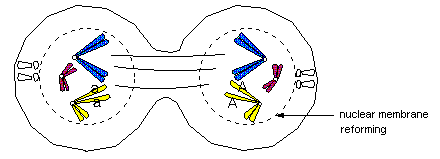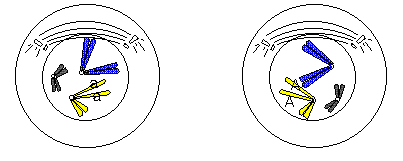
Sex cells, also referred to as gametes (i.e. sperm and egg) are produced in the sex organs (gonad) - testes in males, ovaries in females, through a process called meiosis. The adjective for meiosis is meiotic. In summary, meiosis involves the replication of genetic material followed by two distinct divisions to arrive at half the chromosome number of the other cells in the body (somatic cells). Haploid is the term applied to a cell with half the number of chromosomes. An explanation of meiosis is useful in understanding how genes segregate. It is also useful in understanding how various genetic events (such as, crossover, translocation or inversion) occur during the production of gametes.
Each phase of meiosis is discussed below. Following each explanation is a simple sketch representative of the phase. The sketches only shows six chromosomes for simplicity, a cockatiel has many chromosomes, the exact number is unknown. I also labeled two genes ("A" and "a") that occupy the same loci or chromosomal locations in order to show how genes segregate during the meiotic process. This labeling starts at late prophase I.
1. Early Prophase I
The six chromosomes (three homologous pairs) within the cell become visible. They do not appear double stranded although replication of genetic material has already occurred.












The end result of a single meiosis is four gametes each containing half the genetic complement of the parent. The next phase would be fertilization, where the male gamete combines with the female gamete to restore the normal doubled somatic cell chromosome number (i.e. diploid number), which then develops into an offspring with the genetic contributions from both parents.

